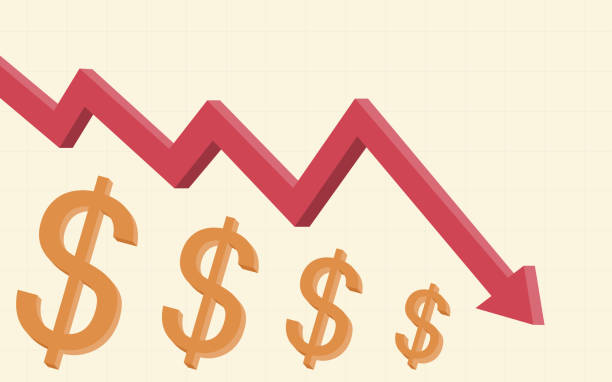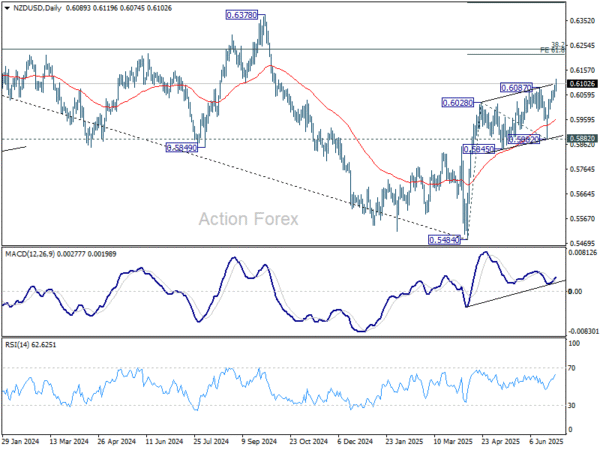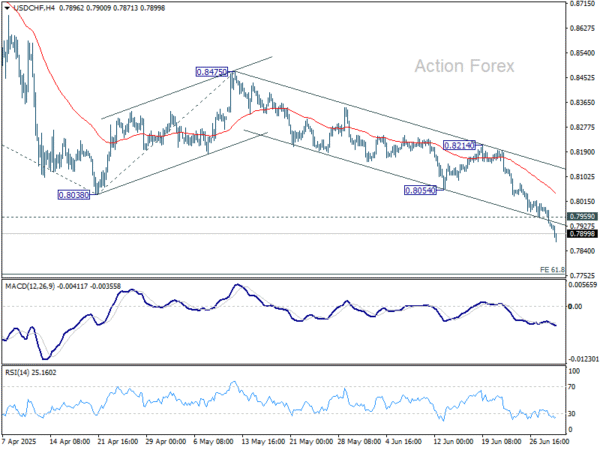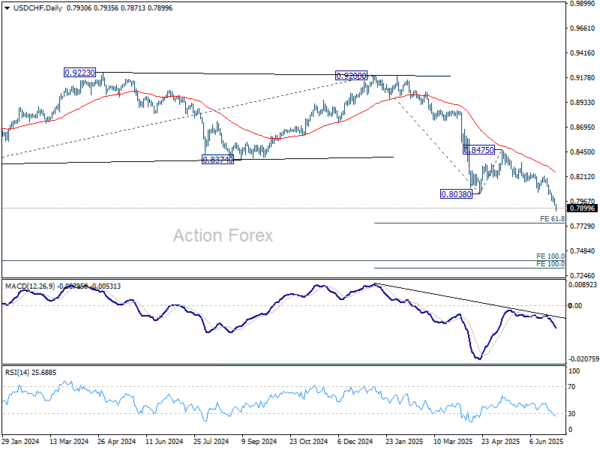Dollar’s slide deepened today as markets leaned harder into expectations of multiple Fed rate cuts in 2025. The move comes even before this week’s key economic data—ISM manufacturing, ISM services, and non-farm payrolls—hits the wires. The greenback’s decline is broad-based, with risk currencies like the New Zealand Dollar and safe havens such as Yen and Swiss Franc outperforming at the same time.
Goldman Sachs now forecasts three rate cuts this year, reversing its earlier call for a single reduction. The shift stems from what it described as “smaller-than-expected” impacts from US tariffs and stronger-than-expected disinflation. Analysts noted that some gauges of household inflation expectations had previously raised concerns, but early signs suggest those pressures may not warrant delaying cuts. The call aligns with market pricing, which now shows a over 96 chance of a September cut and around 65% odds of three total moves.
Alongside monetary policy, fiscal worries are creeping into investor sentiment too. The Senate is expected to vote today on US President Donald Trump’s expansive “Big Beautiful Bill,” a package of tax cuts and spending boosts that would widen the US fiscal deficit by US 3.3 trillion. Treasury Secretary Scott Bessent expressed optimism on the bill’s passage, but questions linger about its long-term economic sustainability, particularly in the context of slower growth and aggressive tariffs.
Markets are also digesting stalled trade negotiations, with the July 9 deadline for new tariffs approaching rapidly. Despite efforts, no breakthroughs have been achieved with key partners like Japan or the EU. Tensions remain high with risk undermining both investor confidence and trade flows.
Technically, NZD/USD’s rally from 0.5484 resumed this week by breaking through 0.6087 resistance. Further rise should be seen to 61.8% projection of 0.5484 to 0.6028 from 0.5882 at 0.6218. Outlook will stay bullish as long as 0.5882 support holds, in case of retreat.
In Europe, at the time of writing, FTSE is down -0.26%. DAX is down -0.65%. CAC is down -0.48%. UK 10-year yield is down -0.06 at 4.429. UK 10-year yield is down -0.056 at 2.552. Earlier in Asia, Nikkei fell -1.24%. Hong Kong was on holiday. China Shanghai SSE rose 0.39%. Singapore Strait Times rose 0.64%. Japan 10-year JGB yield fell -0.044 to 1.392.
Eurozone CPI rises to 2%, core steady at 2.3% in June
Eurozone headline CPI rose from 1.9% yoy to 2.0% yoy, in line with expectations. Core inflation (ex energy, food, alcohol & tobacco) held steady at 2.3% yoy.
The largest inflationary driver came from the services sector, where prices rose 3.3% annually, up from 3.2% in May. Food, alcohol, and tobacco also contributed, albeit slightly less than before, with prices up 3.1% compared to 3.2% the previous month.
Non-energy industrial goods inflation softened to 0.5% from 0.6%, while energy prices continued to fall, though at a slower pace, down -2.7% compared to May’s -3.6%.
ECB officials at Sintra keep slight dovish bias as easing cycle nears end
At the ECB’s annual forum in Sintra, policymakers reinforced that it’s is nearing the end of its easing cycle, even though further rate cut cannot be ruled out.
Chief Economist Philip Lane emphasized that the “last cycle” of battling post-pandemic inflation is over, having brought price growth down from 10% to near the 2% target. Still, he clarified that being “done” with the previous cycle does not rule out additional moves if circumstances change, particularly as the eurozone faces lingering uncertainty from global trade tensions and weak growth.
Belgian central bank chief Pierre Wunsch echoed the sentiment, saying the “job is mostly done” on inflation but that risks are now tilted to the downside. Wunsch added that ““if we have to move more it probably will be to the downside, a further cut.”
Latvian central banker Martins Kazaks added that any future moves would likely be small and designed as fine-tuning or “insurance cuts.” He cited Euro’s recent appreciation as a potential drag on inflation and exports, reinforcing the case for a cautious bias toward easing.
Vice President Luis de Guindos said that while the current EUR/USD exchange rate—hovering near 1.17—is not concerning, a rapid move beyond 1.20 would begin to pose challenges for inflation and competitiveness. “But 1.20 is perfectly acceptable.”
Lithuania’s Gediminas Šimkus also leaned dovish, stating that any next move would “be down,” though he remained cautious about timing. He said September might be too early to decide. Simkus added: “I believe a move, if any, is more likely towards the end of the year.”
Eurozone PMI manufacturing finalized at 49.5, divergences persist
Eurozone Manufacturing PMI was finalized at 49.5 in June, up slightly from 49.4 in May and marking the highest level in nearly three years. The data reflects gradual stabilization across the bloc’s industrial base, with output expanding for the fourth straight month and new orders showing signs of bottoming out. However, the headline figure remains below the 50-mark, signaling the sector is still technically in contraction.
Among individual economies, Ireland (53.7), Greece (53.1), Spain (51.4), and the Netherlands (51.2) led the pack with readings in expansion territory. In contrast, France (48.1), Italy (48.4), and Austria (47.0) continued to weigh on the region, posting multi-month lows. Germany, the bloc’s industrial engine, came in at 49.0—its best level in 34 months, but still shy of expansion.
Hamburg Commercial Bank’s Cyrus de la Rubia noted that longer delivery times and a stabilization in order books are early signs of a pickup in demand, despite ongoing macro risks from tariffs, the Middle East, and Ukraine. He added that if Germany returns to growth—helped by fiscal support from the new coalition—France, Italy, and Austria could follow, given their strong trade ties.
BoE’s Bailey highlights labor weakness and investment hesitation
BoE Governor Andrew Bailey highlighted mounting signs of economic softness in a CNBC interview, pointing to a weakening labor market and subdued investment as key headwinds. “That increase in uncertainty and predictability is definitely coming through in terms of activity and growth,” he said, citing conversations with businesses delaying capital spending.
Bailey reiterated that interest rates are likely to fall “gradually,” offering no specific guidance on the Bank’s next move in August, saying only, “We’ll see.” His tone leaned more dovish, noting that the labor market is “softening” and that this weakness is becoming more visible. Although BoE continues to monitor for sticky inflation, Bailey placed stronger emphasis on downside risks to growth and investment sentiment.
UK PMI manufacturing finalized at 47.7, improving outlook still fragile
The UK manufacturing sector showed tentative “signs of stabilization” in June, with PMI Manufacturing index finalized at 47.7, its highest in five months.
While the reading remains in contractionary territory, the pace of decline in production, new orders, and employment all slowed. Business optimism improved to a four-month high, and the orders-to-inventory ratio — a key forward-looking indicator — surged to its strongest level since August 2024, raising hopes of a potential rebound in output.
Rob Dobson, Director at S&P Global Market Intelligence, noted that inflationary pressures are also easing, with both input costs and selling prices rising at slower rates. However, he warned that any recovery remains vulnerable to multiple external risks. These include ongoing geopolitical tensions, global demand weakness, tariff-related uncertainties, and domestic political shifts.
SNB’s Zanetti says negative rates on the table if needed
SNB board member Atillio Zanetti signaled that policymakers are not ruling out a return to negative interest rates if economic conditions warrant it.
“It’s not an obvious step to go into negative rates,” Zanetti said, acknowledging the unconventional nature of such a move, “but I wouldn’t say that we don’t want to do that if that’s necessary.”
He emphasized that while negative rates remain a tool in the SNB’s arsenal, their effectiveness differs from conventional policy. “We are aware that the transmission of monetary policy with negative rates is different than in positive territory.”
BoJ Tankan signals resilience, keeps 2025 hike option alive
Japan’s Q2 Tankan survey showed business sentiment holding firm despite intensifying trade tensions. While today’s Tankan beat won’t trigger immediate action, it keeps the door open for a BoJ hike policy shift before year-end, especially if trade risks stabilize.
Large manufacturers posted a headline index of +13, beating expectations of 10, and reaching the highest level since December 2024. Their forward outlook for September came in at +12, also topping forecasts of 9. The services side was more mixed. Large non-manufacturers remained steady at +34, meeting expectations, but this marked a softening from prior readings, with the September outlook dipping to +27.
Still, capital expenditure plans surprised to the upside: large firms projected FY2025/26 capex to rise 11.5% (vs. 10.0% expected), while small firms were slightly less pessimistic than forecast. The investment data points to continued confidence in the domestic recovery.
Inflation expectations remained broadly stable. Firms anticipate CPI to rise 2.4% over both one-year and three-year horizons—unchanged to slightly lower from the previous survey.
Japan’s PMI manufacturing finalized at 50.1, demand still fragile
Japan’s Manufacturing PMI was finalized at 50.1 in June, rising from 49.4 in May. While production and employment ticked higher, underlying demand remained weak.
According to S&P Global’s Annabel Fiddes, firms reported continued declines in both domestic and overseas sales, reflecting the lingering impact of global uncertainty—particularly around US tariff policy.
Despite soft demand, business sentiment improved, encouraging firms to boost output and hiring. However, Fiddes emphasized that a “renewed and sustained improvement in customer demand” is still needed to drive a broader recovery.
Price pressures also “picked up slightly”, with both input costs and selling prices rising above their long-term averages, suggesting inflationary risks remain embedded in supply chains.
China Caixin PMI manufacturing rises to 50.4, but optimism fades
China’s Caixin PMI Manufacturing rose to 50.4 in June from 48.3, topping expectations of 49.0 and marking a return to expansion territory. However, Wang Zhe of Caixin Insight cautioned that job losses persisted, external demand remained weak, and price pressures were subdued.
While the latest figures point to near-term stabilization, underlying risks remain elevated. Wang stressed that domestic demand has yet to see a fundamental turnaround and that businesses have grown less optimistic. With logistics and purchasing activity still soft, and global uncertainty intensifying, the sustainability of June’s rebound remains in question unless further policy support or demand recovery materializes.
NZIER survey shows NZ business confidence rising, inflation pressures easing
New Zealand business confidence improved modestly in Q2, with a net 22% of firms expecting better conditions ahead, up from 19% in Q1, according to NZIER’s quarterly survey.
Inflationary pressure appears to be cooling. 1% of firms reported price cuts in Q2, a sharp turnaround from the 8% that raised prices in Q1.
The report pointed to a continued “divergence between firms experiencing weak demand and firms expecting a recovery in demand”, underlining an uneven domestic outlook despite improved sentiment.
NZIER said the effect of interest rate cuts since last August has yet to fully feed through to real activity, despite supporting sentiment.
USD/CHF Mid-Day Outlook
Daily Pivots: (S1) 0.7908; (P) 0.7951; (R1) 0.7974; More….
USD/CHF’s decline is in progress and break of the near term falling channel suggests downside acceleration. Intraday bias stays on the downside for 61.8% projection of 0.9200 to 0.8038 from 0.8475 at 0.7757. Firm break there will pave the way to 100% projection at 0.7313 next. On the upside, above 0.7959 minor resistance will turn intraday bias neutral first. But recovery should be limited by 0.8054 support turned resistance to bring another fall.
In the bigger picture, long term down trend from 1.0342 (2017 high) is still in progress. Next target is 100% projection of 1.0146 (2022 high) to 0.8332 from 0.9200 at 0.7382. In any case, outlook will stay bearish as long as 0.8475 resistance holds.





